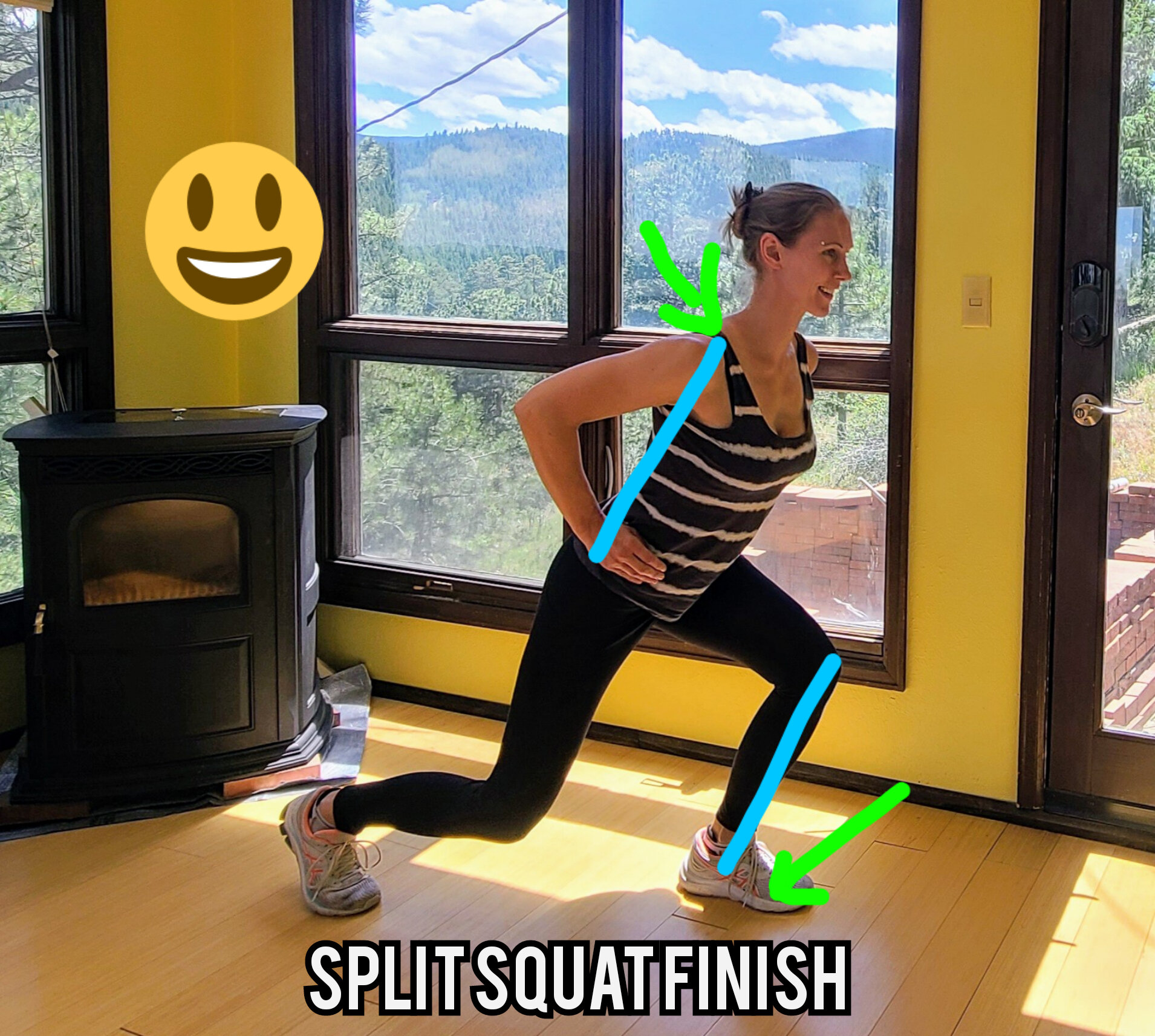Common Mistakes of Squats and Lunges and How to Correct Them
Robyn is posing at the bottom of a split squat with arrows and lines pointing out correct alignment. The picture title reads, “Split Squat Finish.”
Squats and lunges are at the heart of any full-body workout. These two exercises do quite a bit to activate your glutes and strengthen hips. In fact, squats and lunges can help eliminate knee pain when done properly. Here’s a look at how to properly do squats, split squats, and lunges.
About this Guide to Squats and Lunges
As a personal trainer for over 10 years and a Corrective Exercise Specialist, I’m an expert in proper form for squats and lunges. In this guide to squats and lunges, we will cover:
Why you should do squats and lunges
Proper front lunge techniques
The most efficient squat technique
How to do a split squat
Common problems with squats
Why Squats and Lunges Should Be a Part of Your Workout
Lunges and squats are essential exercises that are a quick and easy way to get that much-needed glute activation. Your glutes and hips are your powerhouses, without them, you’ll find yourself potentially suffering from over-tightened quads, knee pain, back pain, and more.
Lunges and squats act like peanut butter and jelly. Squats put your butt and core to work, while lunges focus on your hips, giving you stability and strengthening your pelvic girdle.
Even with hypermobility, squats split squats, and lunges can be a safe and effective part of your workout program for managing joint stability and pain.
Proper Form for a Front Lunge
Robyn Fog demonstrates proper movement and form for front lunges and split squats
The front lunge gets a bad rep. Many people avoid lunges because they hurt their knees. If you’re hurting from a lunge, it probably means you’re doing it wrong. Here’s how to properly perform a front lunge:
Start with your feet together. Take one step forward (not outward) with enough room to create a 90-degree bend behind both knees.
After stepping forward, bend your knee to 90 degrees and drop your back leg to 90 degrees. You’ll want to keep your front knee stacked over your ankle. A (very) slight) forward motion is okay, but try to keep everything in line.
At the bottom, your shoulders should be over your hips and your hips over your back knee. Keep your torso straight and upright with your shoulder blades back and down.
Keep your weight split 50/50 on both feet during a lunge.
Activate your glutes by squeezing your butt cheeks together to stand back up and press firmly through the front heel to do so.
Switch legs and repeat.
If you find your knees hurt from a front lunge, do a rear lunge. The process is the same, but step back instead of forward.
Forward Lunge Start
Forward Lunge Finish
Common Lunge Mistakes
Lunges, although a basic exercise, are often done incorrectly. Keep your lunge form in tip-top shape by avoiding these common mistakes.
Not stepping forward enough to create a true 90-degree bend
Don’t allow your back ankle to collapse and turn your toes out.
Don’t round your shoulders or lean forward
Keep your chin parallel to the floor, don’t let it jut out. If this happens, pretend you are holding a grapefruit under your chin for proper alignment.
Don’t bend your front knee without bending your back knee. Don’t let your front knee go past your front toes.
Keep your tailbone tucked under, don’t stick your butt out, and avoid arching your lower back.
Poor Form for Lunges and Split Squats
Proper Form for a Squat
Squats are the powerhouse move that delivers total body strength. Here’s how to master the squat:
Stand with your legs hip-width apart.
Keep your feet parallel, no more than a 15-degree turnout of your toes.
Squat by dropping your butt down and keeping your torso parallel to your shins. Keep your heels on the floor
It’s okay for your knees to go in front of your toes a little bit, as long as your torso and shins are parallel and your knees stay in line with your 2nd and 3rd toes through the whole movement. (Don’t hunch or round forward too much).
Your shoulders should end up lined up around the balls of your feet (a little in front or behind is okay).
Keep your chest lifted.
Squeeze your butt and push evenly through your heels and the balls of your feet. Keep your foot firmly planted and big toes pressed down.
Bottom position for deep squat showing proper alignment
Common Squat Mistakes
Do sit into your heels and keep your big toes grounded. Often people shift too far forward in their feet which forces them to compensate with poor form.
Do keep your back and shins parallel. If you tend to lean too far forward and stick your rear out, you may experience more knee or lower back pain. Think about keeping your ribcage stacked over your pelvis and use mirrors or a video to spot-check your form.
If you are hypermobile, make sure you do not lock your knees at the top of the squat. Stop with your knees very slightly bent and in line with your 2nd and 3rd toes
Proper Form for a Split Squat
Get your butt in gear with the ultimate glute workout - the split squat. The Split Squat should be used to get maximum benefit per rep. This stability-inducing movement gets your glutes activated and helps you improve your powerhouse. Here’s how to do a split squat:
Start with your feet together with one foot in front of the other. Both feet should be facing forward and parallel. Keep your feet hip-width apart.
Put 80% of your weight on your front foot with 30% on the back.
Keep your upper body and front shin parallel and your chest forward. Keep your shoulder blades back and down to align your spine and put your pelvis in optimal position.
Bend both knees and pick your back heel up, keeping that 80/20 balance on your front foot. Your front foot should stay firmly planted and nearly all the weight should be in your front heel.
Bend into the squat below a 90-degree angle. You should feel your front leg butt muscle working hard. If you don’t, check that your front heel stays down. Keep your upper back straight and hinge forward slightly at the hips so that if you were to hold a bar across your upper back the bar would end up just over or behind the ball of your front foot.
Engage your butt muscles and use them to stand back up but do not bring your feet together. Keep them in a splice stance.
Split Squat Start
Split Squat Finish
Common Split Squat Mistakes
A lot of people don’t do split squats properly; here are a few common mistakes to remember:
Do shift your weight forward over your front foot, many people don’t shift enough weight forward by hinging forward at the hips
Don’t round your shoulders and collapse forward, keep your shoulders back and down and focus on hinging at your hips.
Do keep your chin tucked towards your chest; don’t let your chin tilt up or your head protrude forward.
Don’t push yourself back up instead of activating your glutes. You want to squeeze back up with your butt but don’t bring your feet together.
When it comes to proper form for squats, split squats, and lunges, it’s important to really focus on proper form. Once you’ve nailed the form, your workout will be more effective and impactful.
Side Notes
If Split Squats or Lunges cause pain around the pubic bone, try taking a break from single-leg and off-set exercises such as lunges and split squats. Focus on stable, even-stance exercises, such as the squat, and make sure you're using proper form. It’s always a good idea to check in with your medical care team if you experience pain of any sort in addition to before you start any exercise program.








